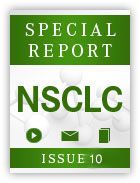Combining Immunotherapy With Anti-VEGF Agents Rigorously Explored in NSCLC
The success of the immunotherapies pembrolizumab and nivolumab for the treatment of non-small cell lung cancer (NSCLC), and the promising results in NSCLC for the investigational agent atezolizumab, have generated an interest in new combinations with other agents
Immunotherapy Anti-VEGF Agents in NSCLC

Benjamin P. Levy, MD
The success of the immunotherapies pembrolizumab and nivolumab (monoclonal antibodies binding to the PD-1 receptor) for the treatment of nonsmall cell lung cancer (NSCLC), and the promising results in NSCLC for the investigational agent atezolizumab (an anti–PD-L1 antibody), have generated an interest in new combinations with other agents.1-3
Among these for which clinical trials are starting or are under way are the biologic angiogenesis inhibitors bevacizumab (antibody binding to VEGF) and ramucirumab (antibody binding to VEGFR2), and the multikinase inhibitor, lenvatinib.4-6Bevacizumab and ramucirumab, are both approved for the treatment of NSCLC (Table 1).
Table 1
Biologic Anti-VEGF Agent
Indication for NSCLC
Bevacizumab
Nonsquamous NSCLC with carboplatin and paclitaxel for first-line treatment of unresectable, locally advanced, recurrent or metastatic disease
Ramucirumab
In combination with docetaxel, for treatment of metastatic NSCLC with disease progression or after platinum-based chemotherapy. Patients with EGFR or ALK genomic tumor abberations should have disease progression on FDA-approved therapy for these aberrations before receiving ramucirumab
Lenvatinib is indicated for the treatment of patients with locally recurrent or metastatic, progressive, radioactive iodine-refractory differentiated thyroid cancer. It is a receptor tyrosine kinase (RTK) inhibitor, inhibiting the activities of VEGFR1, VEGFR2, and VEGFR3, in addition to other RTKs involved in pathogenic angiogenesis, tumor growth, and disease progression.5
Commenting on the approved antiangiogenic therapies for NSCLC, Benjamin P. Levy, MD, medical director of thoracic medical oncology for Mount Sinai Health Systems and the associate medical director of the cancer clinical trials office for Mount Sinai Hospital, New York, said, “Currently, the only antiangiogenic agents approved in NSCLC are the VEGF antibodies, bevacizumab, and ramucirumab, as both have demonstrated survival advantages in treatment-naïve and chemotherapy-refractory patients, respectively,” and he added, “Unfortunately, multiple VEGF small molecule inhibitors have been evaluated in NSCLC and have failed to demonstrate any clinically meaningful improvement in outcomes. Thus, none of the small molecule VEGF inhibitors is approved in NSCLC.”
Current Ongoing Trials of Anti-VEGF Agents in Combination With Immunotherapy in NSCLC
Bevacizumab and Atezolizumab
Bevacizumab and Pembrolizumab
Study NCT02366143 is a phase III randomized, open-label study evaluating the safety and efficacy of atezolizumab in combination with carboplatin and paclitaxel, with or without bevacizumab, versus carboplatin, paclitaxel and bevacizumab. It is recruiting chemotherapy-naïve patients with stage IV, nonsquamous NSCLC. The primary endpoint is progression-free survival (PFS). Secondary outcome measures include objective response (OR), overall survival (OS), duration of response, and safety. The study aims to recruit 1200 patients. Study start date was March 2015 and the estimated primary completion date is January 2017.
Bevacizumab and Nivolumab
A randomized, open-label, phase I/II study (NCT02039674) is recruiting patients to determine the safety and efficacy of pembrolizumab with chemotherapy or immunotherapy in patients with unresectable or metastatic NSCLC. In part 1, cohort B, patients will be administered pembrolizumab in combination with paclitaxel, carboplatin, and bevacizumab. Other part 1 cohorts (A ,C, D, E, F,) will test pembrolizumab in combination with other agents such as paclitaxel and carboplatin, pemetrexed and carboplatin, ipilimumab, erlotinib, and gefitinib. The primary outcome measure for all cohorts in part 1 is the recommended phase II dose for pembrolizumab in combination with chemotherapy or immunotherapy. The estimated enrollment is 308 patients. The study began in February 2014 and is still recruiting patients. The estimated primary completion date is November 2016.
A phase I/II randomized, open-label study (NCT02574078CheckMate 370) will assess the clinical benefit and safety of nivolumab monotherapy versus nivolumab with standard of care, in patients with advanced NSCLC. The study is not yet open for recruitment but will examine the clinical effects of nivolumab as maintenance therapy after induction with chemotherapy, nivolumab as first-line monotherapy, and nivolumab in combination with standard of care. Experimental group A will assess nivolumab with bevacizumab versus bevacizumab alone. The primary outcome measures for group A are PFS and OS, with duration of response and objective response rate (ORR) as secondary outcome measures. The study aims to recruit 1953 patients and is listed as starting in November 2015, with an estimated completion date of February 2019.
Study NCT01454102 (CheckMate 012) is ongoing and not recruiting. It is a phase I, randomized, open-label trial, and there is no formal research hypothesis to be validated statistically. There are 19 experimental arms, testing the safety and tolerability of nivolumab as monotherapy or in combination with gemcitabine/cisplatin, pemetrexed /cisplatin, carboplatin/paclitaxel, bevacizumab maintenance, erlotinib, and ipilimumab (primary outcome measures). Secondary outcome measures are overall response rate and PFS for specific arms of the study. The study recruited patients with newly diagnosed and confirmed stage 3b/4 NSCLC. The estimated enrollment was for 412 patients and the estimated completion date is November 2017.
Ramucirumab and Pembrolizumab
Patients with a range of malignancies, including NSCLC, are being recruited into a nonrandomized, phase I, open-label, multicenter study of ramucirumab plus pembrolizumab (NCT02443324). The primary outcome measure is the number of patients who experience dose-limiting toxicities. Secondary outcome measures include ORR, disease control rate, duration of response, time to first response, PFS, OS, and pharmacokinetics of ramucirumab. The study aims to enroll 92 individuals and began in July 2015, with the estimated completion date of February 2017.
Lenvatinib and Pembrolizumab
Therapeutic Advantages and Which Patients Will Benefit
A phase Ib/II, open-label, single-group assignment trial of lenvatinib with pembrolizumab in subjects with selected solid tumors (including NSCLC) is recruiting patients (NCT02501096). Phase Ib will establish the maximum tolerated dose (MTD) of lenvatinib and the phase II expansion will test this dose for efficacy and safety in 6 cohorts. The primary outcome measures are MTD, ORR, and dose-limiting toxicity. Secondary outcome measures include treatment-emergent adverse events (AEs), treatment-emergent serious AEs, PFS, OS, disease control rate, area under the curve, and clearance rate of lenvatinib. The study began in July 2015 and the estimated completion date is August 2017.
“With regards to combining anti-VEGF agents with immunotherapy, particularly PD-1/PD-L1 agents, there does seem to be preclinical rationale for this approach [since] several studies have demonstrated synergy with this combination,” explained Levy. “One postulated reason is that anti-VEGF therapy many augment checkpoint inhibitors by inhibiting myeloid-derived suppressor cells. Whether this synergy will be also exhibited in NSCLC patients remains unclear at this point, but the data are certainly exciting and worth evaluating in clinical trials.”
Addressing the problem of selecting patients who would benefit from this approach, Levy added, “One of the major challenges with immunotherapeutic approaches in NSCLC is lack of a consensus on an appropriate biomarker. While PD-L1 by immunohistochemistry (IHC) has been a potential candidate, there remain problems with this testing, including tumor heterogeneity and different cut-off points from the varying PD-L1 IHC platforms.”
He also identified the issue of biomarkers for anti-VEGF agents. “In addition, despite bevacizumab being approved for NSCLC for over 10 years, we still have yet to define a biomarker for this drug. So it is very difficult for me to say if there will be a meaningful clinical or molecular enrichment strategy given that neither of the two drugs in the combination strategy have a bona fide biomarker.” However, Levy optimistically added, “Hopefully, future studies will help answer this question.”
References
- http://www.merck.com/product/usa/pi_circulars/k/keytruda/keytruda_pi.pdf Accessed January 4, 2016.
- http://packageinserts.bms.com/pi/pi_opdivo.pdf Accessed January 4, 2016.
- http://www.ascopost.com/issues/october-25,-2015/atezolizumab-makes-inroads-in-non%E2%80%93small-cell-lung-cancer.aspx Accessed January 4, 2016.
- http://www.gene.com/download/pdf/avastin_prescribing.pdf Accessed January 4, 2016.
- http://www.accessdata.fda.gov/drugsatfda_docs/label/2014/125477lbl.pdf Accessed January 4, 2016.
- http://www.accessdata.fda.gov/drugsatfda_docs/label/2015/206947s000lbl.pdf Accessed January 4, 2016.
